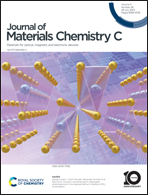A skin-friendly soft strain sensor with direct skin adhesion enabled by using a non-toxic surfactant†
Abstract
Wearable electronics, particularly soft strain sensors with direct skin adhesion, play a crucial role in applications such as smart healthcare systems and human–machine interfaces. However, the existing approaches for developing dry-adhesive soft electronic materials often involve potential biotoxicity and vulnerability to humid environments. In this study, we present an eco-friendly and biocompatible surfactant-based composite for soft conductive composite, soft dry-adhesive film, and skin-adherable soft strain sensors. Utilizing polyoxyethylene sorbitan monooleate, also known as Tween 80, as a non-toxic surfactant, polydimethylsiloxane (PDMS) as an elastomeric matrix, and poly(3,4-ethylenedioxythiophene) polystyrene sulfonate (PEDOT:PSS) as a conductive pathway, the composite exhibits excellent stretchability and conductivity. The soft dry-adhesive film based on Tween 80-added PDMS features exceptional softness and adhesiveness. We demonstrate a soft strain sensor based on these composites that can be directly adhered to the skin and effectively detect various human motions involving large deformations without delamination. This approach offers a promising avenue for future wearable electronics that are safe for both humans and the environment.

- This article is part of the themed collection: Journal of Materials Chemistry C Emerging Investigators


 Please wait while we load your content...
Please wait while we load your content...